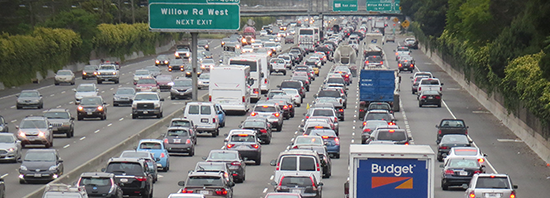San Mateo County Releases Draft Strategic Plan for Spending Sales Tax Revenue
2:20 PM PDT on October 29, 2019

Last year, San Mateo County residents passed a half-cent transportation sales tax. Measure W went into effect in July, and is expected to generate more than $90 million a year for "transportation-related improvement projects." Half of the money will be administered by SamTrans and half by the San Mateo County Transportation Authority (TA).
The TA is finalizing its draft strategic plan to guide those investments over the next five years.
Measure W projects are supposed to align with the core principles of the county's Congestion Relief Plan, which was developed with input from county residents and stakeholders in 2018. Those principles include congestion relief, public transportation improvements, incorporating Complete Streets, reducing vehicles miles traveled and greenhouse gas emissions, and incentivizing transit, biking, walking, and carpooling over driving alone.
The ballot measure proposed dividing the funds into five categories:
- 22.5 percent to highway projects, including Highway 101 and 280
- 12.5 percent to major arterial and local roadway improvements in "key congested areas"
- 5 percent to bicycle, pedestrian, and active transportation projects
- 10 percent to infrastructure and services for transit connectivity between San Mateo County and the greater Bay Area region
- 50 percent to local public transit services, including SamTrans and Caltrain
The Silicon Valley Bicycle Coalition helped guide those categories. Emma Shlaes, policy director for the SVBC, described it as a process of finding ways to create criteria for each funding category that would support the measure's core principles.
The SVBC had some recommendations on the draft plan, and some of those have already been accepted.
For example, they called for less emphasis on criteria not directly related to the core principles, such as "readiness." While important, these criteria were proposed to be given more weight in the scoring than some of the principles put forth in the measure. As of Friday, the "readiness" of a project will count for a bit less than originally proposed.
The SVBC had also requested that the TA create a technical assistance program to help cities understand what it takes to score well on Complete Streets improvements. Technical assistance had been included for highway projects as a matter of course and habit, since local agencies don't always have the capacity for designing big interchanges. SVBC had argued that cities need just as much training on Complete Streets principles as they do on highway interchanges. The draft plan now proposes to expand technical assistance.
The SVBC also recommend measuring the travel time savings of high-occupancy vehicles and active transportation, giving that more weight than the time savings of solo drivers. This could help encourage congestion relief without encouraging more driving.
They call for a stronger emphasis on social equity, giving higher weight to those scores across all the categories. And they call for making sure there is an oversight committee that is diverse and has the power to ensure that funding complies with the core principles.
The comment period on the draft plan will remain open until 5 p.m. on Friday, November 15. The plan, and a place to provide comments, can be found here.
The TA will also hold a virtual Town Hall on Monday, November 4, from 2 p.m. to 3 p.m. to present the plan and gather more feedback. Preregistration is required, here.
Stay in touch
Sign up for our free newsletter



